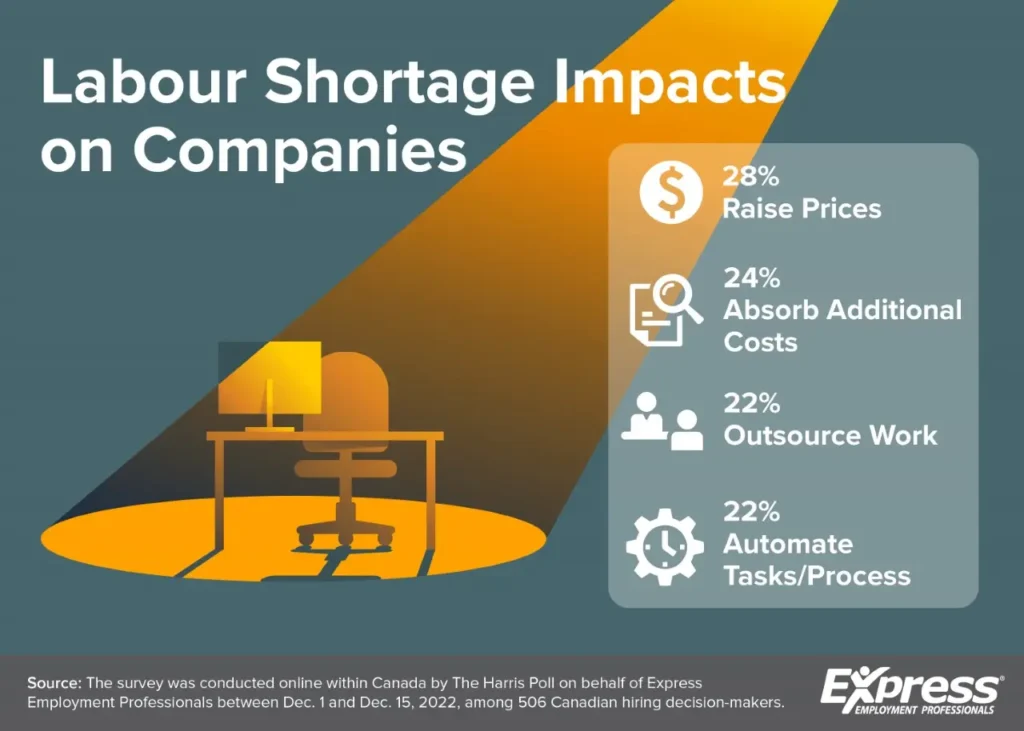In recent years, the term “labour shortage” has become increasingly prevalent in discussions across various industries and regions. This phenomenon is not just a passing concern; it has the potential to shape the future of work and business in profound ways. In this article, we will delve into the concept of labour shortage, explore its causes, and discuss the impacts on businesses. Additionally, we will consider strategies, government initiatives, and long-term solutions to address this pressing issue.
Understanding the Labour Shortage
Definition of Labour Shortage
A labour shortage occurs when the demand for labour exceeds the available supply of qualified workers. It’s a situation where businesses and industries struggle to find and retain skilled employees to meet their operational needs.
Causes of the Current Labour Shortage

Labour shortages are not uniform, and their causes can vary by industry and region. Here are some of the primary factors contributing to the current labour shortage:
- Demographic Shifts: One significant factor is the aging of the population in many developed countries. As more people retire, there are fewer younger workers entering the job market. Additionally, declining birth rates in some regions mean there are simply fewer people available to join the workforce.
- Skills Mismatch: Rapid technological advancements have led to a skills gap. Many workers lack the skills required for the jobs available, leading to a disconnect between employer needs and the available workforce.
- Pandemic Effects: The COVID-19 pandemic disrupted the labour market in multiple ways. It led to layoffs in some sectors while creating high demand in others, making it challenging for workers to transition between industries. It also shifted worker preferences, with more people seeking remote or flexible work arrangements.
- Retirement Wave: Many experienced workers are retiring, leaving a gap that’s difficult to fill. In some industries, this “brain drain” of institutional knowledge poses a significant challenge.
Industries and Regions Most Affected
The impact of labour shortages varies by industry and region. Some industries have been hit particularly hard:
- Healthcare: The healthcare sector has been grappling with a shortage of nurses, doctors, and support staff for years. The pandemic has only exacerbated this issue.
- Construction: Skilled trades, such as electricians, plumbers, and carpenters, have been in high demand as construction projects boom in many areas.
- Technology: The tech industry continually seeks highly skilled professionals in fields like software development, data analysis, and cybersecurity.
- Agriculture: Seasonal labour shortages are common in agriculture, where there’s a need for workers during planting and harvesting seasons.
- Hospitality and Tourism: These sectors rely heavily on customer service workers, and labour shortages can impact the quality of service provided.
Impact of Labour Shortage on Businesses

Decreased Productivity
When businesses are short-staffed, it often leads to increased workloads for existing employees. Over time, this can result in burnout, reduced morale, and decreased overall productivity. Employees stretched too thin may struggle to meet deadlines and deliver quality work.
Increased Labor Costs
With high demand for labour and a limited supply of qualified workers, wages tend to rise. This can put pressure on businesses to increase salaries and benefits to attract and retain talent. For small businesses, this can be particularly challenging, as they may not have the financial resources to compete with larger companies in terms of compensation.
Effect on Customer Service and Quality
Labour shortages can affect the quality of goods and services. Longer wait times, reduced customer service quality, and delayed project deliveries can harm a company’s reputation. For instance, a restaurant with insufficient kitchen staff may have longer wait times for meals, leading to dissatisfied customers.
Potential Long-term Consequences
If left unaddressed, labour shortages can have long-term consequences for businesses. These may include:
- Loss of Market Share: Competitors who effectively address labour shortages may gain a competitive edge, resulting in a loss of market share for businesses struggling to find and retain talent.
- Reduced Competitiveness: A business that cannot attract skilled workers may struggle to innovate and keep up with industry trends, ultimately becoming less competitive in the long run.
- Business Closures: In extreme cases, labour shortages can lead to business closures, particularly among smaller enterprises that lack the resources to adapt.
The Role of Technology in Mitigating Labour Shortage

Automation and Artificial Intelligence
One way businesses are addressing labour shortages is by turning to automation and artificial intelligence (AI). These technologies can perform repetitive tasks with precision and efficiency, reducing the need for human workers in certain roles.
For example, in manufacturing, robots can handle assembly and production tasks, freeing up human workers for more complex and creative tasks. In customer service, chatbots powered by AI can provide instant support to customers, reducing the workload on human customer service representatives.
Upskilling and Reskilling the Workforce
While technology can replace certain jobs, it also creates new opportunities. Businesses are investing in employee development and training programs to bridge the skills gap. This not only helps retain existing employees but also ensures they have the skills needed to adapt to changing job requirements.
For instance, a manufacturing company might provide training in advanced automation systems to its production workers, allowing them to oversee and maintain the machines. Similarly, technology companies often offer continuous training to keep their software developers up-to-date with the latest programming languages and tools.
Strategies for Attracting and Retaining Talent

Competitive Compensation and Benefits
To attract and retain top talent, businesses must offer competitive compensation packages. This includes competitive base salaries, performance-based bonuses, and comprehensive benefits such as health insurance, retirement plans, and stock options.
In a tight labour market, companies that offer attractive compensation packages are more likely to secure the talent they need. It’s not just about paying more than the competition but also offering a comprehensive and appealing benefits package.
Flexible Work Arrangements
The way people work has evolved, with a growing emphasis on work-life balance and flexibility. Offering flexible work arrangements, such as remote work options or flexible hours, can be a significant draw for talent.
Post-pandemic, many workers have come to appreciate the benefits of remote work, and businesses that can offer this flexibility are more likely to attract and retain employees who value it. Flexibility can also be extended to part-time and gig workers, allowing businesses to tap into a broader pool of talent.
Employee Development and Training Programs
Investing in the growth and development of your employees is not only a retention strategy but also a means of ensuring that your workforce remains adaptable and capable of meeting changing demands.
Many businesses offer opportunities for employees to learn new skills, whether through workshops, online courses, or on-the-job training. This not only enhances their value to the company but also boosts their job satisfaction and engagement.
Creating a Positive Workplace Culture
A positive workplace culture is vital for attracting and retaining talent. Employees want to work in an environment where they feel valued, supported, and where their well-being is a priority.
Promoting a culture of inclusivity, diversity, and work-life balance can go a long way in making your company an employer of choice. Additionally, recognizing and rewarding employee contributions, whether through formal recognition programs or informal gestures, can boost morale and job satisfaction.
Government Initiatives and Policies to Address Labour Shortage

Immigration Policies and Workforce Influx
Governments can play a significant role in addressing labour shortages by adjusting immigration policies to allow for an influx of skilled workers. This can be particularly relevant in industries with chronic labour shortages, such as healthcare.
By streamlining the immigration process for qualified workers and offering pathways to permanent residency, governments can ensure that businesses have access to the talent they need to fill critical roles.
Tax Incentives for Businesses
Tax incentives can encourage businesses to invest in workforce development and employee retention programs. For example, a business that invests in training programs for its employees might receive tax credits or deductions.
These incentives not only benefit businesses by reducing their tax burden but also incentivize them to prioritize workforce development, which ultimately benefits the broader economy.
Training Grants and Subsidies
Governments can provide training grants and subsidies to support businesses in upskilling their existing workforce. These programs can help cover the costs of training and development initiatives, making it more affordable for businesses to invest in their employees’ skills.
Training grants are often targeted at specific industries or skills that are in high demand, helping to align workforce development with the needs of the job market.
Supporting Small and Medium-sized Enterprises (SMEs)
Labour shortages can disproportionately affect small and medium-sized enterprises (SMEs) with limited resources. Governments can provide targeted support to SMEs through grants, low-interest loans, and access to training programs.
Supporting SMEs not only helps them navigate the challenges posed by labour shortages but also contributes to economic stability and job creation in local communities.
Preparing for the Future: Long-term Solutions
Education Reforms and Vocational Training
To address the root causes of the skills gap, education systems must undergo reforms. This includes updating curricula to align with industry needs, promoting STEM (science, technology, engineering, and mathematics) education, and expanding vocational training programs.
By ensuring that students graduate with relevant and in-demand skills, educational institutions can contribute to a future workforce that is better prepared for the job market.
Encouraging Entrepreneurship
Entrepreneurship can play a vital role in job creation. Encouraging the creation of new businesses can lead to more job opportunities and a diversified economy.
Governments and organizations can support entrepreneurship through grants, incubator programs, and access to capital. Encouraging innovation and providing resources for startups can lead to job growth and economic resilience.
Building a Diverse and Inclusive Workforce
Diversity and inclusion initiatives are essential for broadening the pool of available talent. A diverse workforce brings a variety of perspectives and experiences to the table, which can foster innovation and creativity.
Businesses can actively promote diversity and inclusion by implementing inclusive hiring practices, offering training on bias and inclusion, and creating an environment where all employees feel valued and heard.
Sustainable Business Practices
Sustainability practices can attract socially conscious workers and customers, enhancing a company’s appeal. Many job seekers today are looking for employers with a commitment to environmental and social responsibility.
Businesses can adopt sustainable practices in areas such as energy efficiency, waste reduction, and ethical sourcing. Communicating these efforts can make a company more attractive to prospective employees and customers alike.
Conclusion: Navigating the Labour Shortage Challenge
In conclusion, the labour shortage is a complex and multifaceted issue that businesses and governments must address collaboratively. By understanding the causes, impacts, and potential solutions, we can navigate this challenge and build a workforce that is resilient, adaptable, and well-equipped for the future. Proactive measures, innovative thinking, and a commitment to investing in human capital will be key to overcoming the labour shortage crisis and ensuring economic prosperity for all.
This expanded blog post provides a comprehensive overview of the labour shortage issue, its causes, impacts on businesses, and a wide range of strategies and solutions to address it. You can use this content as a basis for your article, adding specific examples, statistics, and case studies to further illustrate each point.

